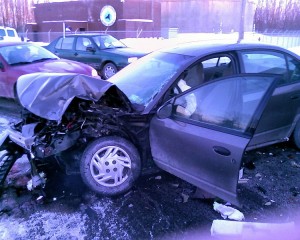 I’ve railed before about some of the problems with New York’s No-Fault law, and it appears the Legislature may finally be ready to act. The No-Fault law forms the framework around which all New York auto accident lawsuits are evaluated, so this is no small deal.
I’ve railed before about some of the problems with New York’s No-Fault law, and it appears the Legislature may finally be ready to act. The No-Fault law forms the framework around which all New York auto accident lawsuits are evaluated, so this is no small deal.
Back 30+ years ago, the idea was that all auto accident victims would get insurance for their injuries regardless of fault, but the trade-off was that only those that crossed a “serious injury” threshold could bring an action for damages. That meant the the law had to define medicine, which is no easy task.
The basic problem regarding the threshold was medical technology was limited as to what could be seen. So while the law still uses the technology from decades gone by, we now find ourselves in a situation where a fractured pinkie qualifies as a serious injury, but surgery needed for a torn rotator cuff, herniated disk, or torn meniscus, might not.
The MRI, CT, EMG and ultrasound were, at that time the statute was drawn, dreams in the heads of inventors, or experimental prototypes not widely used as diagnostic tools. The x-ray was state of the art when the statute was drawn. So the legislature defined the threshold in these nine ways:
- A personal injury that results in death;
- Dismemberment;
- A significant disfigurement;
- A fracture;
- The loss of a fetus;
- Permanent loss of use of a body organ, member, function or system;
- Permanent consequential limitation of use of a body organ or member;
- Significant limitation of use of a body function or system; or
- A medically determined injury or impairment of a non- permanent nature which prevents the injured person from performing substantially all of the material acts which constitute such person’s usual and customary daily activities for not less than ninety days during the one hundred eighty days immediately following the occurrence of the injury or impairment.
The first five are clearly objective measurements. The next four are fuzzier, and they have been fought over time and time again due to a lack of clarity in the statute, particularly the language of “permanent consequential limitation” and “significant limitation.” And the ninth one, referred to as the 90/180 test, is problematic because it clearly favors those with good work benefits who can thus afford to stay home and nurse their injuries. Those that are self-employed may not have that option, and would work despite having the exact same injuries. And the stay at home mom is really in trouble, as she doesn’t have that clock to punch, thereby creating documentation for time missed. The 90/180 rule actually encourages people to miss work.
As it developed, the law also was found to favor those patients that chose doctors fluent in legalese, to deal with some of the odd requrirements that courts started adding to the statute. Courts started demanding, for example, “objective” findings that were made “contemperaneous” with the accident. That language doesn’t exist in the statute. Lawyers would read decisions and tell doctors what the evolving standards were, to the best they could be defined. And woe unto the accident victim that merely went to a doctor that simply wanted to practice medicine and heal the patient. Now that doctor was forced to write medical-legal reports. And they couldn’t just write like they were trained in medical school and residencies. They had to adopt the language of judges.
Another problem was the accusation that insurance companies were using sham medical exams to cut off the No-Fault benefits. There is no shortage of complaints in New York of 5-minute exams where a doctor finds no objective evidence of injury and the insurance company cuts off the benefits that were supposed to come as the trade-off for surrendering their right to sue.
Last year, a very frustrated Supreme Court Bronx Paul Victor took a shot across the bow of this law, with a long rant about legislative defects, inconsistent appellate decisions and “a great expenditure of limited judicial time” trying to define “elusive standards” in the law.
How does the Legislature fix the problems?
The Legislature might finally bring the statute into the 21 century, although these technologies were available before the calendar turned 10 years ago and so are long overdue. The idea that a fractured pinkie would be a “serious injury,” while back, shoulder and knee injuries that result in surgeries would not be, is a great example of how a law was turned on its head.
Introduced two weeks ago, the new bill would clarify the definition of the threshold, by specifically by further defining “serious injury” as:
- a partial or complete tear or impingement of a nerve, tendon, ligament, muscle or cartilage;
- injury to any part of the spinal column that results in injury to an intervertebral disc;
- impingement of the spinal cord,spinal canal, nerve, tendon or muscle;
- surgery
It should be noted that many of these things already might fall under the definition under the present definitions. The problem is, as Judge Victor pointed out, that it’s largely up to the judge, and the judges do not apply the law evenly. So that currently it’s a crap shoot on which judge (or appellate panel) is assigned to the case. Judge Victor was clear that we have slid a long way from the even administration of law.
Roy Mura over at Coverage Counsel has a different view, as he writes from the insurance company perspective. He sees an expansion of the injuries that qualify under the proposed changes. But he fails to take into account the essential ambiguity in the law as it tries mightily to define medicine, especially given that medicine has moved forward over the last 30+ years. Nor has he accounted for the problems that Judge Victor discussed with the uneven administration of justice, with some judges tossing out cases while others would allow the exact same ones to go forward. The bill leaves this essential fact-finding function to the jury, where it belongs.
Vagueness and ambiguity have no place in the law. It creates problems as courts get swamped with motions and appeals that they are ill-prepared to deal with if a legislature hasn’t done a good job of establishing definitions.
The bill would bring some fundamental fairness to New York’s No-Fault law, seeing to it that all people are treated the same. And that can only be a good thing if you happen to be the person that was injured.
You can find the Assembly version of the bill with its sponsors, here: Assembly Bill A10739
You should be able to find the Senate version here: Senate Bill S7518
 Former First Lady Laura Bush has conceded negligence in the November 6, 1963 car crash she was involved in at age 17, in Midland, Texas. She concedes running a stop sign and hitting another car, killing its driver. The driver of the other car, Michael Douglas, was a start athlete and friend of hers.
Former First Lady Laura Bush has conceded negligence in the November 6, 1963 car crash she was involved in at age 17, in Midland, Texas. She concedes running a stop sign and hitting another car, killing its driver. The driver of the other car, Michael Douglas, was a start athlete and friend of hers.

